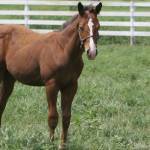Cold Weather Weaning Practices Impact Foal Health

No matter how one goes about weaning a foal, the process remains one of the most stressful events in a horse’s life, alongside transport and introduction into a new herd. Stress often causes immunosuppression, leaving the foal’s immune system weaker than normal and unable to fight off infection. Because of this, respiratory tract infections occur commonly in foals at the time of weaning.
One weaning approach involves introducing foals from different farms into a loose housing system with access to a paddock and shelter. According to one research group*, this approach, used for approximately 30% of weanlings in Finland, allows foals to move freely, engaging in normal social behaviors with peers. Researchers found this method of weaning satisfactory for the health and development of young horses.
Mixing horses always brings a risk of respiratory tract infections. Foals in Finland and other countries in northern climates are typically weaned during the winter when temperatures can fall as low as -4° F (-20° C) for several weeks. Therefore, a better understanding of the impact of unheated, loose housing for newly weaned foals mixed from different farms on respiratory health will benefit these foals.
To achieve this, the research team observed two groups of foals from 11 different farms. In total, 36 foals were kept in unheated loose housing systems and 24 were maintained in insulated stables with daily turnout in paddocks. The researchers found:
- Older foals were less likely to develop respiratory diseases than younger foals;
- When the available space for sleeping was reduced and when the sleeping area was not insulated, foals had higher blood fibrinogen levels—a measure of systemic inflammation; and
- Foals in loose housing systems had lower body condition scores than stabled foals, possibly due to increased mobility.
“The housing system did not impact respiratory health in this study. The researchers suggest, however, that foals in unheated loose housing systems may need additional feed to maintain appropriate body condition, and that stabling foals over the winter might be a better approach,” summarized Kathleen Crandell, Ph.D., a nutritionist for Kentucky Equine Research (KER).
Supplementing a mare’s diet with omega-3 fatty acids during pregnancy and lactation provides natural protection to the foal by minimizing stress and inflammation associated with weaning. Look for EO•3, a marine-derived oil rich in the omega-3 fatty acids DHA and EPA, to support mare and foal health. Australian horse owners should look for these research-proven products.
To help determine the best way to feed your foal at time of weaning, consult with a KER nutrition advisor.
*Junkkari, R., H. Simojoki, M.L. Heiskanen, et al. 2017. A comparison of unheated loose housing with stables on the respiratory health of weaned foals in cold winter conditions: An observational field-study. Acta Veterinaria Scandinavica. 59(1):73.








